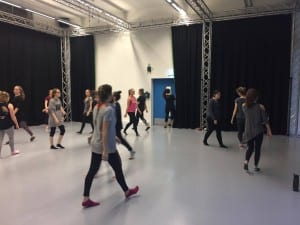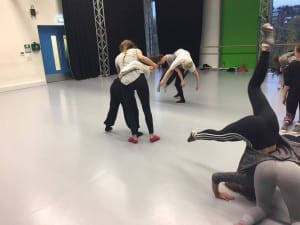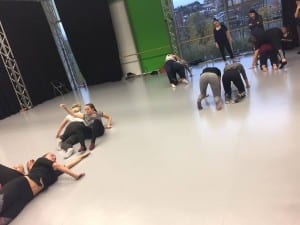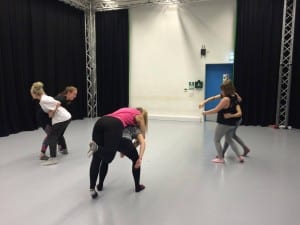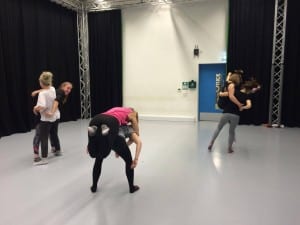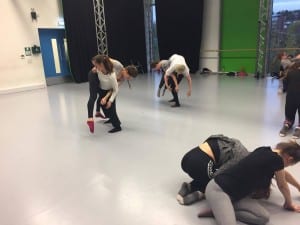This week we worked with a release and contact based company called feet off the ground who are an all female company. We explored different lifts and counter balances, some we had never explored before, by exploring these new lifts and counter balances I was able to work with new bodies I had not necessarily worked with before, this gave me an opportunity to experience a different connection within my own body and just working with another body in a whole.
Towards the end of the workshop with feet off the ground, we learnt a release and contact phrase, even though we only had 45 minutes to learn and perform, I felt positive with my skills and the end result. After the workshop I reflected on the day and reflected on how I can put everything we’ve learnt into a jam situation, I feel I have more movement to explore within my own body.
‘How do we use the three stages of preparation to develop confidence in weight baring lifts?’
We chose to base out research lab around this question because we felt it was a common flaw in most of the classes practice. We based our research to back up our research lab on this weeks reading ‘Exposed to Gravity’. We found it really related to our research lab, as it talks about a man who found new confidence within CI, finding the trust and connection in another body, finding grounding through the floor even in weight baring lifts, ‘on top of Alan’s shoulders I could feel the ground through his body solidly supporting me against gravity” (Curtis, 1998, 158). Curtis and Ptashek also discuss gaining fearlessness through using momentum and weight exchange.
To make sure we gained all the research we needed we spit the 20-minute session in two halves’, starting off with exercises we have explored before such as body surfing incorporating table top, with their starting position and ‘safe’ position table top, we wanted to see if they explored new movement and challenged themselves to work their way through to table top from body surfing.
We then upped the difficulty of the task so their safe position was now one from table top and one from standing, challenging them further to look at movement they wouldn’t have necessarily found working from the normal starting and safe positions.
During this exercise we found that many duets had started to explore with new movement, they started to find the standing connection earlier on which allowed them to explore movement for longer. We didn’t want to chose pacific songs, as Curtis explains “Alan, discouraged this because the body tends to move to the internal rhythm of the shifting weight, sensation and the communication that goes back and forth between the dancers.” (Curtis, 1998, 158). We wanted them to explore at their own pace, which we realised very early on they it was a very slow pace, which made each of the movements controlled, it also meant they kept their connection, allowing movements to flow better.
‘Keep your eyes open, don’t get lost inside your head. Look for opportunities to support your partner, move in underneath them. Don’t give or take weight without listening for the agreement of your partner’s body’(Curtis, 1998, 158), We used this quote within our session because as a group, as we researched for a question we noticed that whilst in a jam we started to plan what we wanted to do, we got lost in all the different ideas we wanted to explore, we stopped listening to our partner’s body and the connection started to leave.
For the second part of our workshop we still wanted the group to explore the transitions between getting from the floor to standing, but we decided to go in reverse so we started with both bodies standing in the space, and we asked them to reverse the practice, so they go from standing to table top and then back to standing again, we also banned body surfing.
For the second stage of this exercise, we carried on with the same idea, but we banned table top and body surfing. We did this because we wanted the bodies in the space to find different ways of moving across the space, ways they had never thought about moving and by restricting the movements they were allowed to do this made them stray away from their habitual movements.
We felt even though the group found the exercises difficult, it managed to challenge them and create new movement even if the group didn’t recognise it in themselves.
We saw a change in the confidence in the group, it was really easy to spot groups that were taking the time to explore and exploring ways to move the connection between the bodies.
In the second set of exercises we used the quote ‘Mutual trust is based on uncompromised attention, so stay in the present moment’ (Curtis, 1998, 158). We used this quote because we felt it was relevant to the group at the time, as they were moving from weight baring lifts to different points on the body, the trust between the two bodies was the main thing needed to maintain the flow and connection.
Photos from our workshop.
Bibliography
Curtis, B. (1988). Exposed to Gravity. Contact Quarterly/ Contact Improvisation Sourcebook I, Vol. 13
